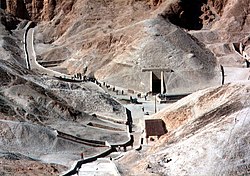
Back Vallei van die Konings Afrikaans Tal der Könige ALS وادي الملوك Arabic وادى الملوك ARZ Valle de los Reis AST Krallar vadisi Azerbaijani Батшалар үҙәне Bashkir Даліна Цароў Byelorussian Долина на царете Bulgarian রাজাদের উপত্যকা Bengali/Bangla
| Valley of the Kings وادى الملوك ϫⲏⲙⲉ (Coptic) Ta-Sekhet-Ma'at (Egyptian) | |
|---|---|
 View of the central East Valley, showing the area around KV62. | |
| Location | Luxor, Egypt |
| Coordinates | 25°44′27″N 32°36′8″E / 25.74083°N 32.60222°E |
| Built | c. 16th century BC |
| Built for | Egyptian New Kingdom |
| Official name | Ancient Thebes with its Necropolis |
| Type | Cultural |
| Criteria | i, iii, vi |
| Designated | 1979 (third session) |
| Reference no. | 87 |
| Region | Arab states |
The Valley of the Kings,[a] also known as the Valley of the Gates of the Kings,[b][2] is an area in Egypt where, for a period of nearly 500 years from the Eighteenth Dynasty to the Twentieth Dynasty, rock-cut tombs were excavated for pharaohs and powerful nobles under the New Kingdom of ancient Egypt.[3][4]
It is a wadi sitting on the west bank of the Nile, opposite Thebes (modern-day Luxor) and within the heart of the Theban Necropolis.[5] There are two main sections: the East Valley, where the majority of the royal tombs are situated; and the West Valley, otherwise known as the Valley of the Monkeys.[6][7]
With the 2005 discovery of a new chamber and the 2008 discovery of two further tomb entrances,[8] the Valley of the Kings is known to contain 65 tombs and chambers, ranging in size from the simple pit that is KV54 to the complex tomb that is KV5, which alone has over 120 chambers for the sons of Ramesses II.[9] It was the principal burial place for the New Kingdom's major royal figures as well as a number of privileged nobles. The royal tombs are decorated with traditional scenes from Egyptian mythology and reveal clues to the period's funerary practices and afterlife beliefs. Almost all of the tombs seem to have been opened and robbed in antiquity, but they still give an idea of the opulence and power of Egypt's pharaohs.
This area has been a focus for Egyptologists and archaeological exploration since the end of the 18th century, and its tombs and burials continue to stimulate research and interest. The Valley of the Kings garnered significant attention following the discovery of the tomb of Tutankhamun in 1922,[10] and is one of the most famous archaeological sites in the world. In 1979, it became a UNESCO World Heritage Site alongside the rest of the Theban Necropolis.[11] Exploration, excavation, and conservation continues in the area and a new tourist centre has recently been opened.
- ^ "Trismegistos". www.trismegistos.org. Retrieved 19 November 2017.
- ^ Reeves and Wilkinson (1996), p. 6
- ^ Maspero (1913), p. 182
- ^ "Theban Mapping Project". Theban Mapping Project. Retrieved 4 December 2006.
- ^ Siliotti (1997), p. 13
- ^ Richard H. Wilkinson; Kent Weeks (2016). The Oxford Handbook of the Valley of the Kings. Oxford U. p. 24. ISBN 978-0-19-049399-8.
[A side valley of the West Valley was called the Vallée du gardien Khaouy] The main part of the West Valley continues to the left and is called Bibân el-Gurud, Les Portes des Singes, or "The Valley of the Monkeys," a scene in KV 23.
- ^ Thomas R. Gensheimer (2017). World Heritage and National Registers. Taylor & Francis. p. 120. ISBN 978-1-351-47100-8.
This area is known locally as the Wadi el-Gurud, or Valley of the Monkeys, because of a scene of twelve baboons carved on a wall in KV 23.
- ^ Zahi Hawass. "Spotlight Interview: 2008". The Plateau: Official Website for Dr. Zahi Hawass. Retrieved 15 August 2008.
- ^ "Valley of the Kings". Theban Mapping Project. Archived from the original on 19 July 2008. Retrieved 9 August 2008.
- ^ Winstone 2006, pp. 141–166.
- ^ "Ancient Thebes and its necropolis". UNESCO Work Heritage Sites. Retrieved 4 December 2006.
Cite error: There are <ref group=lower-alpha> tags or {{efn}} templates on this page, but the references will not show without a {{reflist|group=lower-alpha}} template or {{notelist}} template (see the help page).
